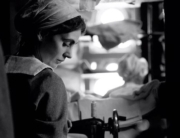
Leonardo DiCaprio and Lily Gladstone in Killers of the Flower Moon (Melinda Sue Gordon/Apple Original Films)
In adapting David Grann’s eponymous 2017 best-selling nonfiction page-turner, there is more than enough material for a 206-minute film. Nevertheless, the structure of cowriter/director Martin Scorsese and Eric Roth’s screenplay comes out lopsided.
Grann’s book focused on the procedural investigation of the murders of wealthy members of the Osage Nation that occurred in 1920s northern Oklahoma. (His subtitle: The Osage Murders and the Birth of the FBI.) Scorsese and Roth, however, self-consciously step away from emphasizing the solving of the landmark case during the early days of Edgar J. Hoover’s reign. Instead, the courtship and marriage of a White newcomer to Osage County, World War I vet, gambler, and heavy drinker Ernest Burkhart (Leonardo DiCaprio), and Mollie (Lily Gladstone) take center stage. She’s one of four daughters of an Osage family that struck it rich from black gold—oil.
According to Scorsese, the question surrounding the crimes is not a whodunit, but a who-didn’t-do-it. Given the filmmakers’ approach, the mystery of who was involved vanishes from the start. The step-by-step depiction of the web of lies, corruption, and violence are often plodding. Though the on-screen murder spree is not sensationalized, the multiple killings come across as perfunctory, with actors hitting their marks before a gun goes off and a body falling to the ground. (Did the B unit film them?)
Much of the first 150 minutes centers on the scheming behind the premeditated murders, as well as Ernest and Molly’s marriage. Because the culprits have been revealed almost from the get-go, the audience’s desire for justice is prolonged. Any kind of resolution is thwarted until the final 45 minutes when Tom White (Jesse Plemons), Grann’s main subject, arrives from Washington, DC, and starts probing. Even those who haven’t read Grann’s book will sense that White’s role in the unraveling of the crimes has been greatly reduced. With truncated trial sequences, Scorsese also refrains from turning the saga into a courtroom drama.
Of Scorsese’s recent epics of the last 20 years, this one does not fly by as briskly as The Irishman or The Wolf of Wall Street. It settles into a calmer tempo of personal interactions, from the poignant (Mollie and Ernest’s honeymoon period) to the plentiful sit-downs between Ernest and his uncle, William Hale (Robert De Niro), a cattle baron, deputy sheriff, and benevolent big cat of the county. It’s not for nothing that Ernest calls his uncle King.
Inertia sets in as the two lead actors coast in automatic mode. De Niro’s kingpin jarringly recalls his characterizations of similar bad guy roles as he tilts his head in puzzlement or with a smirk while keeping his voice calm and retaining a twinkle in his eye—you could be watching his Al Capone in The Untouchables. DiCaprio also clings to his character’s traits, relying on a fixed downward-turned expression. Otherwise, his Ernest remains a cipher. One reason for the steady, settled pace is the lack of variation in DiCaprio and De Niro’s portrayals. It doesn’t help that as Hale molds and bends his nephew to his will, there’s a lot of telling and not enough showing.
Although there are large crowd scenes and a sequence involving a long roaming tracking shot (a Scorsese signature), the movie is also the director’s stagiest work for the staid blocking of his actors. They too often stand/sit near each other in a medium two-shot or are filmed from over the shoulder. Dialogue doesn’t begin until one or both conspirators sits down. Scorsese gave his longtime editor, Thelma Schoonmaker, little latitude; the tone was set by the actors and the limited camera positions.
During preproduction in 2020, the screenplay originally centered on the detective work. When Scorsese’s frequent collaborator DiCaprio expressed interest in playing Ernest Burkhart rather than Tom White, the focus shifted to Ernest and Mollie’s marriage, which certainly is fascinating, considering Ernest’s part in the conspiracy against Mollie and her family.
When does Mollie realize her husband has set out to kill her and her family? This is the adaptation’s genuine mystery, and Scorsese keeps you guessing. As played by Gladstone, Mollie is a much-needed calming, thoughtful, and pragmatic presence. Here, Scorsese and Roth add ambiguity, eschewing an easy psychological map. Mollie’s no fool—she agrees with her sisters early on that Ernest is after her money. Yet, Mollie becomes mainly reactive as the body count increases and her storyline becomes reduced to the beautiful-woman-in-danger trope. (Of all the plot threads, this one will keep viewers in their seats.)
Though Mollie is a lead protagonist and tribal elders have a voice, the movie’s perspective lies more with Ernest’s brisk descent into murder than from an Osage point of view. In scenes with Gladstone, DiCaprio’s movie star charm shines through, enough for you to believe Ernest has swept Mollie off her feet. Yet the film deliberately shies away from confronting a question that would contradict the unconvincing love story: Considering the blood on his hands, is Ernest actually capable of loving anyone?






Leave A Comment